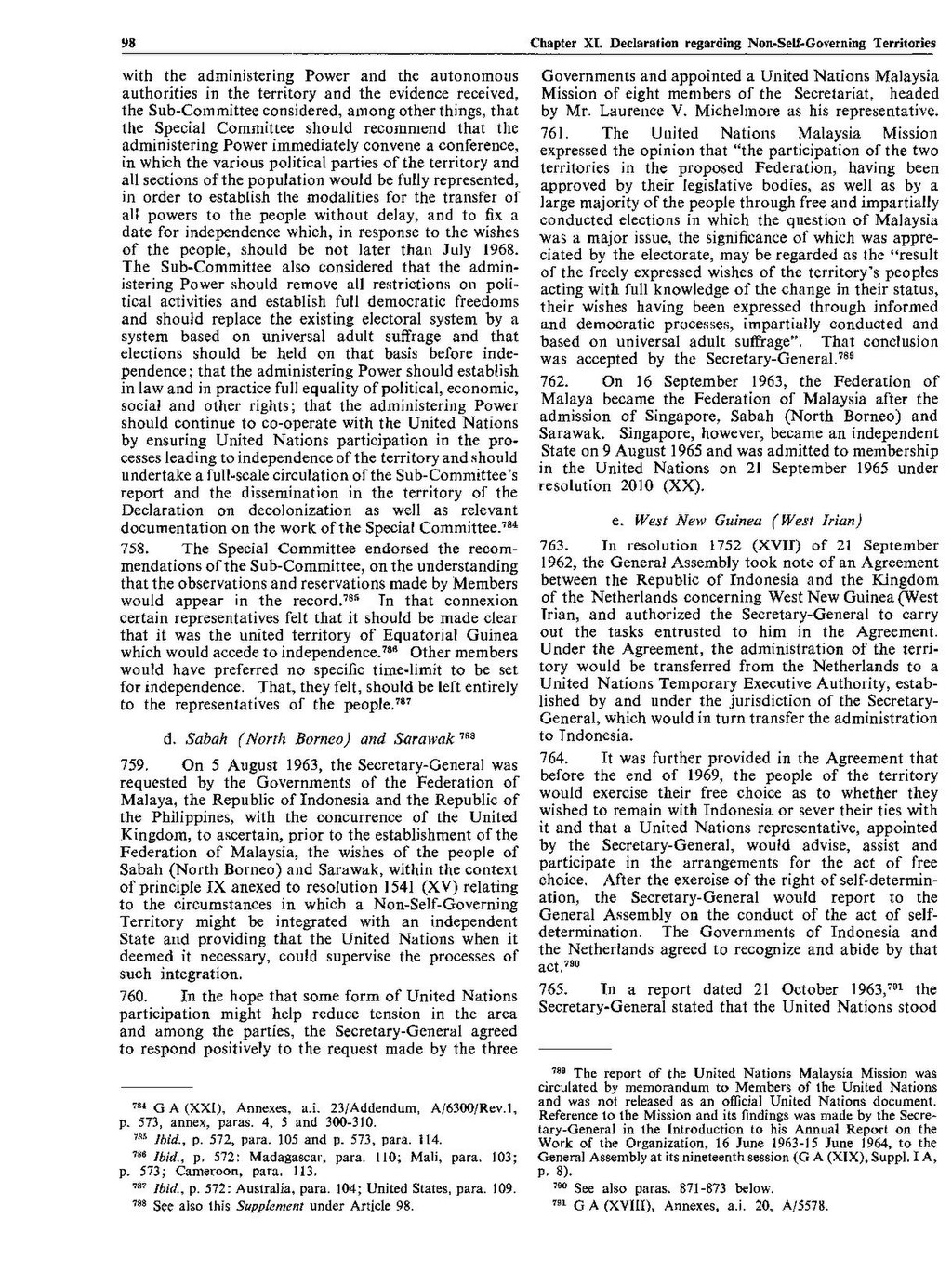with the administering Power and the autonomous authorities in the territory and the evidence received, the Sub-Committee considered, among other things, that
the Special Committee should recommend that the administering Power immediately convene a conference, in which the various political parties of the territory and all sections of the population would be fully represented,
in order to establish the modalities for the transfer of all powers to the people without delay, and to fix a date for independence which, in response to the wishes of the people, should be not later than July 1968.
The Sub-Committee also considered that the administering Power should remove all restrictions on political activities and establish full democratic freedoms
and should replace the existing electoral system by a system based on universal adult suffrage and that elections should be held on that basis before independence; that the administering Power should establish in law and in practice full equality of political, economic, social and other rights; that the administering Power should continue to co-operate with the United Nations by ensuring United Nations participation in the processes leading to independence of the territory and should undertake a full-scale circulation of the Sub-Committee's report and the dissemination in the territory of the
Declaration on decolonization as well as relevant documentation on the work of the Special Committee.[1]
758. The Special Committee endorsed the recommendations of the Sub-Committee, on the understanding that the observations and reservations made by Members would appear in the record.[2] In that connexion
certain representatives felt that it should be made clear that it was the united territory of Equatorial Guinea which would accede to independence.[3] Other members
would have preferred no specific time-limit to be set for independence. That, they felt, should be left entirely to the representatives of the people.[4]
d. Sabah (North Borneo) and Sarawak[5]
759. On 5 August 1963, the Secretary-General was requested by the Governments of the Federation of Malaya, the Republic of Indonesia and the Republic of the Philippines, with the concurrence of the United Kingdom, to ascertain, prior to the establishment of the Federation of Malaysia, the wishes of the people of Sabah (North Borneo) and Sarawak, within the context of principle IX anexed to resolution 1541 (XV) relating to the circumstances in which a Non-Self-Governing Territory might be integrated with an independent State and providing that the United Nations when it deemed it necessary, could supervise the processes of such integration.
760. In the hope that some form of United Nations participation might help reduce tension in the area and among the parties, the Secretary-General agreed to respond positively to the request made by the three Governments and appointed a United Nations Malaysia Mission of eight members of the Secretariat, headed by Mr. Laurence V. Michelmore as his representative.
761. The United Nations Malaysia Mission expressed the opinion that "the participation of the two territories in the proposed Federation, having been approved by their legislative bodies, as well as by a large majority of the people through free and impartially conducted elections in which the question of Malaysia was a major issue, the significance of which was appreciated by the electorate, may be regarded as the "result of the freely expressed wishes of the territory's peoples acting with full knowledge of the change in their status, their wishes having been expressed through informed and democratic processes, impartially conducted and based on universal adult suffrage". That conclusion was accepted by the Secretary-General.[6]
762. On 16 September 1963, the Federation of Malaya became the Federation of Malaysia after the admission of Singapore, Sabah (North Borneo) and Sarawak. Singapore, however, became an independent State on 9 August 1965 and was admitted to membership in the United Nations on 21 September 1965 under resolution 2010 (XX).
e. West New Guinea (West Irian)
763. In resolution 1752 (XVII) of 21 September
1962, the General Assembly took note of an Agreement between the Republic of Indonesia and the Kingdom of the Netherlands concerning West New Guinea (West Irian, and authorized the Secretary-General to carry out the tasks entrusted to him in the Agreement.
Under the Agreement, the administration of the territory would be transferred from the Netherlands to a United Nations Temporary Executive Authority, established by and under the jurisdiction of the SecretaryGeneral, which would in turn transfer the administration to Indonesia.
764. It was further provided in the Agreement that before the end of 1969, the people of the territory would exercise their free choice as to whether they wished to remain with Indonesia or sever their ties with it and that a United Nations representative, appointed by the Secretary-General, would advise, assist and participate in the arrangements for the act of free choice. After the exercise of the right of self-determination, the Secretary-General would report to the General Assembly on the conduct of the act of self-determination. The Governments of Indonesia and the Netherlands agreed to recognize and abide by that act.[7]
765. In a report dated 21 October 1963,[8] the Secretary-General stated that the United Nations stood
- ↑ G A (XXI), Annexes, a.i. 23/Addendum, A/6300/Rev.l, p. 573, annex, paras. 4, 5 and 300-310.
- ↑ Ibid., p. 572, para. 105 and p. 573, para. 114.
- ↑ Ibid., p. 572: Madagascar, para. 110; Mali, para. 103; p. 573; Cameroon, para. 113.
- ↑ Ibid., p. 572: Australia, para. 104; United States, para. 109.
- ↑ See also this Supplement under Article 98.
- ↑ The report of the United Nations Malaysia Mission was circulated by memorandum to Members of the United Nations and was not released as an official United Nations document. Reference to the Mission and its findings was made by the Secretary-General in the Introduction to his Annual Report on the Work of the Organization, 16 June 1963-15 June 1964, to the General Assembly at its nineteenth session (G A (XIX), Suppl. I A, p. 8).
- ↑ See also paras. 871-873 below.
- ↑ G A (XVIII), Annexes, a.i. 20, A/5578.
